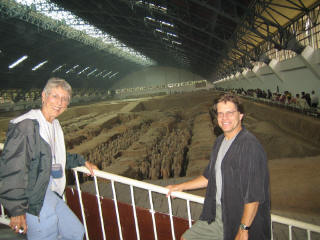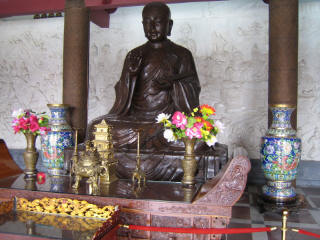|

       
An ancient capital in
central China's Shaanxi province...
|
|

Qin Terra Cotta army
excavation pit #1 |
Xian (pronounced See-An) is
dubbed the 'eternal city' due to its role as one of the
four great ancient capitals of the world (along with
Athens,
Cairo and Rome). Through Xian's
3100 year history, 13 dynasties including Zhou, Qin, Han
and Tang had their capitals here. Ironically, the icon
of Xian in modern times was discovered accidentally by
peasants digging a well in 1974, when they unearthed the
2300 year old Qin Shi Huang burial site and its Terra
Cotta army. |
|
|
We arrived
at Xian airport around 9am where we were met by our driver and
guide. Xian seemed less congested and more modern than
Beijing, although at 7 million people it is no small town and
its history is actually much longer. We visited three major sites that day: the
Big Wild Goose Pagoda, the
Qin Shi Huang Terra Cotta army
excavation and the Huaqing Hot Spring
stopping only for an authentic Sichuan Hot Pot lunch. |

Carved Buddha at Big Wild Goose
Pagoda |
|
We headed
first to the 1400 year old Big Wild Goose Pagoda, located in a
southern suburb. As Buddhism moved to China along the Silk
Road in ancient times, the Big Wild Goose Pagoda functioned
primarily to collect Buddhist materials from India taken by
the hierarch Xuanzang (first picture above, entrance statue).
Why it is called Big Wild Goose Pagoda? According to legend,
there were two Buddhist branches, for one of which eating meat
was not a taboo. One day, they couldn't find meat to buy. Upon
seeing a group of big wild geese flying by, a monk said:
'Today we have no meat. I hope the merciful Bodhisattva will
give us some.' At that very moment, the leading wild goose
broke its wings and fell to the ground. All the monks were
startled and believed that Bodhisattva showed his spirit to
order them to be more pious. They established a pagoda where
the wild goose fell and stopped eating meat.
Another version attributes the
shape of the of the corners at each tier to the form of a
goose's wings in flight (second picture above). Entering the
courtyard flanked by a bell and drum tower, is an ornate
incense burner (third picture above). Before the Pagoda, the
Hall of Mahavira houses three carved Sakyamuni statues (large
picture top of page right). Beyond the 60 meter tall Pagoda is
the Hall of Xuanzang Sanzang with ornate carvings in ivory,
wood and jade (fourth picture above), with its view of the
back of the Pagoda (fifth picture above). Leaving the Big Wild
Goose Pagoda, we headed downtown for an authentic Sichuan Hot
Pot lunch, where we cooked our own mutton, noodles and veggies in a
vat of boiling broth. |
|
Qin Shi
Huang ascended to the throne at age 13 in 246BC. He was to
become the first emperor of all of China. Along that route he
made a lot of enemies, so he fashioned his burial grounds,
which took 39 years to complete, with an army of over 7000
terra cotta warriors and horsemen set in battle formation to
protect him in the afterlife (large picture top of page left
and third picture above). The figures each stand approximately
5'11" and while no two are alike, they can be grouped by
types: chariot warriors (first picture above), infantrymen
(second picture above), cavalrymen, and horses (fourth picture
above). There are generals (fifth picture above), middle
ranking officers, lower ranking officers, ordinary soldiers,
and armored warriors. The latter can be further divided
according to their headgear into warriors with a square scarf,
a cylindrical bun (second picture above), or a flat bun. There
are both standing and kneeling warriors. Originally the
figures were painted bright colors, but over 2000 years of
standing guard the colors have faded.
The excavation site was
discovered in 1974 by some peasants digging a well and
consists of four large pits and staging areas (first picture
below) which have all been covered by building structures to
prevent damage to the site. The emperor's tomb itself (second
picture below) has not been opened and much of the second,
third and fourth pits on the site have not been fully
uncovered yet. In addition to all the terra cotta figures,
bronze chariots were uncovered, partially restored (third
picture below) and are on display in a museum next to the
site. |
|
Leaving the
Terra Cotta army site in the late afternoon, we made a quick
stop in town to visit the Huaqing Hot Spring, site of a 6000 year old natural
hot spring and 3000 year old palace made famous as the
romantic getaway for Emperor Xuanzong and his beautiful
concubine Yang Guifei (statue fourth picture above) in the
seventh century. There are a series of hot spring-fed pools in
buildings that surround a man-made lake. From the Huaqing Hot
Spring we headed to Xian airport for our evening return to
Beijing. |

       
Mackey Group, Inc.
© 2002 - 2010
|
|